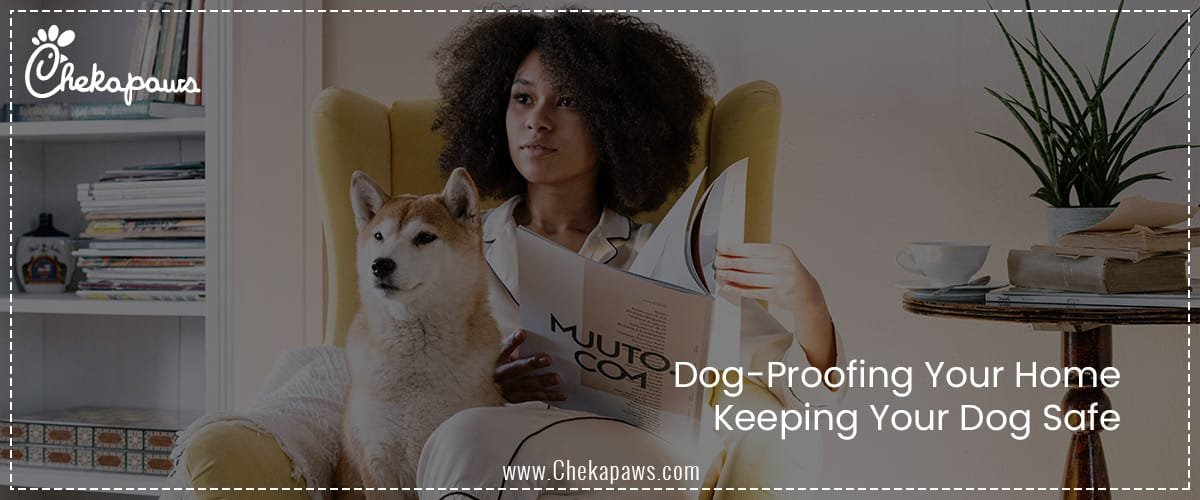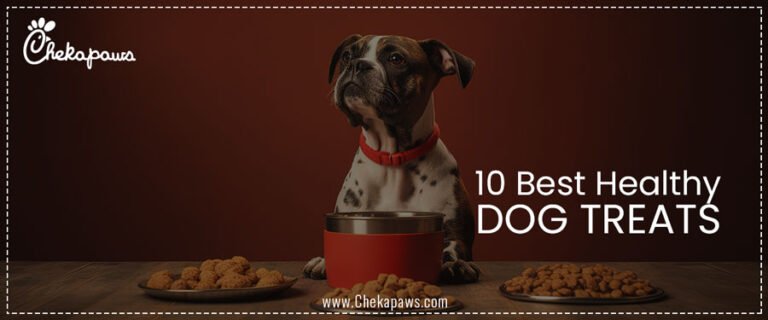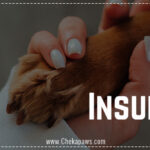As a pet parent, I can relate to the joy and transformative power of bringing a dog into your home. However, dog-proofing your house is an essential step to guarantee your pet’s safety, much like baby-proofing a house for a baby.
Dogs smell, chew and occasionally swallow to explore their surroundings because they are inherently interested. A dog may be seriously harmed by seemingly innocuous objects, such as an open trash can, an unsecured cable, or a dish of grapes.
Here’s the ultimate guide you need to know about making your house dog-safe. We’ll assist you in creating a home that is safe and hazard-free for your dog, in addition to being comfortable and welcoming.
Table of Contents
Understanding Dog Behavior and Common Hazards
Dog-proofing is about more than just protection—it’s about fostering an environment where your dog can thrive, play, and relax safely, bringing you peace of mind.
Why Dogs Get into Trouble
Anyone who’s ever raised a dog knows curiosity is a powerful force—especially in puppies. From the moment my Labrador, Chester, skidded across the kitchen tiles in his first week, I realized my home was a minefield of temptations. But why are dogs so prone to mischief?
- Natural Instincts: Dogs explore the world with their mouths and noses, which means chewing, sniffing and investigating are standard behaviors—especially for breeds with high hunting or retrieving drives.
- Energy & Boredom: High-energy pups or those left alone often channel their restlessness into exploring off-limit areas.
- Separation Anxiety: Dogs left home alone may chew or dig to comfort themselves or alleviate stress.
Most Common Household Hazards
According to the various leading Animal Hospital Associations like American Animal Hospital Association (AAHA) and the ASPCA, the most frequent dangers in the average home include:
- Toxic foods: Chocolate, grapes, raisins, onions, garlic, xylitol, macadamia nuts.
- Medications: Even over-the-counter pills like ibuprofen or acetaminophen can be fatal.
- Household chemicals: Cleaning supplies, laundry detergents and even some essential oils.
- Choking hazards: Coins, buttons, small toys, hair ties, socks and jewelry.
A survey of veterinarians in 2023 reported that more than 60% of pet injuries inside the home resulted from preventable hazards—primarily ingestion of non-food items or exposure to toxins.
Why Dog-Proofing Matters
Maintaining the Health of Your Dog – By dog-proofing, mishaps like poisoning, choking, or injuries from sharp or breakable objects are avoided.
Protecting Against Property Damage – When a dog is bored, nervous, or interested, they may accidentally damage valuables, furniture, or carpets.
Promoting Positive Behavior – Creating a controlled and secure atmosphere supports training initiatives and aids in establishing limits.
Pet Owners’ Peace of Mind – You may leave your dog alone without worrying all the time because you know your house is safe.
General Dog-Proofing Principles
See the World from Their Perspective – Look around while on your hands and knees. What can your dog knock down, chew, or reach?
Safeguard All Dangerous – Cover sharp edges, keep poisonous materials out of reach, and keep choking dangers out of reach.
Use Gates and Barriers – Doors, pens, and stair gates can be used to limit access to restricted locations.
Look at Your House Frequently – Because dogs mature and develop new habits, what was safe for a puppy might not be the same for an older dog.
Room-by-Room Safety Tips
Kitchen
Some of the most hazardous dog hazards are found in the kitchen.
Typical Risks
- Human food (xylitol, grapes, onions, and chocolate)
- Sharp items, such as scissors and knives
- Warming devices (toasters, stoves)
- Chemicals for cleaning beneath the sink
- Cans for trash
Solutions
- Install cabinet latches that are child-proof.
- Use trash cans that are dog-proof.
- Food should be kept well out of reach.
- Keep an eye on your dog while you’re cooking.
The Living Room
Although this is frequently the dog’s play or nap area, there are certain dangers involved.
Typical Risks
- Cords for electricity
- Houseplants, some of which are poisonous
- Open flames or candles
- Items of fragile décor
- Rocking chairs and recliners
Solutions
- Hide cables or use cord covers.
- Eliminate or swap out poisonous plants (such as aloe or lilies).
- Keep delicate objects out of reach.
- Keep an eye on moving furnishings.
Bedroom
Dogs enjoy sleeping in your bedroom, but you may need to make some changes.
Typical Risks
- Hair ties, jewellery, and small items
- Prescription drugs
- Socks or loose clothing
- Electric blankets and heating pads
Solutions
- Keep nightstands free of clutter.
- Keep medications in a safe place.
- Make use of lidded laundry baskets.
Bathroom
There are tempting but dangerous things in bathrooms.
Typical Risks
- Water from the toilet (with cleaning tablets)
- Shampoos, soaps, and razors
- Drugs
- Cleaning supplies
Solutions
- Keep the lids of the toilets closed.
- Use cabinet safety latches.
- Keep goods on high shelves.
Garage or Utility Room
This area is often the most dangerous for pets.
Typical Risks
- Antifreeze (even in trace amounts, deadly)
- Sharp objects and tools
- Pesticides and rodenticides
- Motor oils or fertilizers
Solutions
- Don’t let the dog in the garage.
- Keep goods in locked cabinets or on high shelves.
- Use substitutes that are safe for pets.
Outdoor Safety
Protect the Yard
Your garden ought to be a sanctuary rather than a danger.
Essentials
- No loose panels or gaps in the fence
- Lack of access to compost or poisonous plants
- Garages and outbuildings that are locked
Typical Risks
- Cocoa shell-based mulch (hazardous)
- Weed killers and pesticides
- Unattended garden tools
Safety in Pools
Make sure your dog is safe in the pool if you have one.
Tips
- Make use of a pool cover or fence.
- Teach your dog to locate the steps in the pool.
- Don’t ever leave your dog alone.
Patio or Balcony
These areas can be dangerous yet also welcoming.
Risks
- Railing gaps
- Summertime hot surfaces
- Furniture that is dangerous to climb on
Solutions
- Use nets or screening.
- Offer water and shade.
- Keep an eye on balcony time.
Puppy-Proofing vs. Adult Dog-Proofing
Puppy-Proofing
Puppies get into everything, chew, and dig.
Important Areas
- Teething aids to lessen furniture chewing
- Mats for potty training
- Training in crates
Dogs in Adulthood
Although their behaviors are more established, adult dogs may still explore.
Areas of Focus
- Preventing boredom
- Setting and maintaining boundaries
- Age-related medical considerations
Senior Dogs
Older dogs may have vision or mobility problems.
Things to think about
- Non-slip flooring
- Stairs or ramps for couches or beds
- Water and food are readily available.
Common Household Items That Are Dangerous
Foods to Avoid
- Chocolate
- Grapes/raisins
- Onions and garlic
- Alcohol
- Avocado
- Macadamia nuts
- Xylitol (found in sugar-free gum and peanut butter)
Toxic Plants
- Lilies
- Aloe vera
- Sago palm
- Tulips
- Dieffenbachia
- Poinsettias
Human Medications
- Painkillers (ibuprofen, acetaminophen)
- Antidepressants
- Cold and flu medications
Cleaning Products
- Bleach
- Ammonia
- Disinfectant sprays
- Toilet bowl tablets
Setting Up a Safe Dog Zone
Why It’s Beneficial
You may exert control over your pet’s surroundings and offer them a sense of security by designating a specific space for dogs.
Things to Bring – A cosy bed or crate
- Chews and toys
- Bowl of water
- Pads for puppies (if needed)
Where to Set It Up
Select a peaceful, low-traffic place that is yet visible from family activities.
Traveling and Temporary Safety Measures
Vacation Rentals or Hotel Rooms
- Bring your own bed and containers for food and water.
- Pay attention to outlets and wires.
- To keep dangerous regions out, use gates.
Households and Friends
- Enquire about readily available food, cleaning supplies, or medications.
- Monitor interactions with the pets of the residents.
Vehicle Security
- Use harnesses that have been crash-tested.
- Your dog should never be left in a parked car.
- Carry water and take frequent bathroom breaks.
Training to Support Dog-Proofing
“Drop It” and “Leave It” – When it comes to avoiding ingesting harmful substances, these commands are invaluable.
Training in Crates – It is simpler to handle a well-trained dog who perceives the crate as a secure environment.
Redirecting Chewing – Reward appropriate behavior and provide suitable alternatives.
Regular Boundaries – To enforce no-go areas, use gates, directives, and routines.
Monitoring and Technology
Cameras for pets – You can interact with your dog from a distance and check on them thanks to smart cams.
Smart Sensors – Unusual behavior, like as barking or pacing, can be detected by motion sensors or noise alarms.
Collars with GPS – GPS collars allow you to rapidly track your dog’s location in the event of an escape.
Emergency Preparedness
Pet First Aid Kit
Have necessities on hand
The Gauze
- Peroxide of hydrogen (under a veterinarian’s supervision to induce vomiting)
- Tweezers
- A thermometer that is digital
- Bandages
Emergency Contacts – Save the numbers for your nearest emergency animal hospital, poison control and veterinarian.
Fire Safety – Place labels that read “Pet Inside” on windows and place a crate or leash next to exits.
Advice for Families with Multiple Dogs
Time Spent Feeding – To prevent disputes or food aggressiveness, use distinct feeding places.
Rules for Toys – Every dog needs its own set of toys. Watch out if someone has a tendency to protect toys.
Space and Boundaries – Ensure each dog has access to its own bed or crate to decompress.
Conclusion
To keep your dog safe, healthy, and content, dog-proofing your house is a continuous effort rather than a one-time event. You can provide a safe haven where your pet may flourish by being vigilant, spotting possible dangers, and modifying your surroundings to suit your dog’s requirements and behaviour.
Whether you’re sharing your space with an elderly dog or raising an inquisitive puppy, careful planning and a close eye make all the difference. Your home can become your dog’s favorite safe haven in the world if you take the proper precautions. Your dog depends on you to keep them safe.







